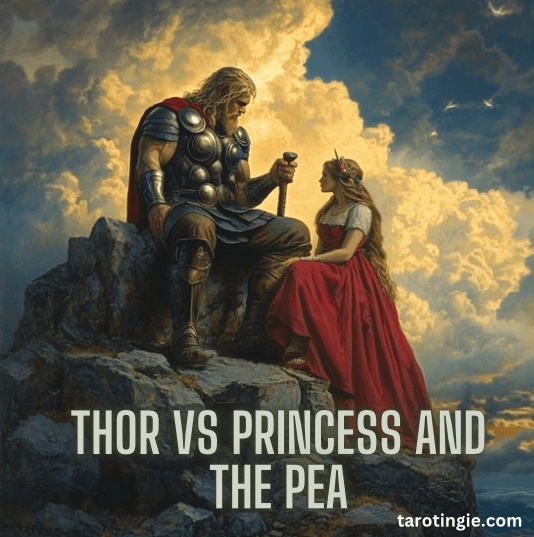The Surprising Link Between Thor And The Princess And The Pea

Thor Vs Princess And The Pea
Old fairytales are often a retelling of old Norse myths. In this case, the Princess and the Pea aims to summarise the deeper meaning of Thor. The story can be interpreted as an allegory for sensitivity, authenticity, and the hidden trials of true nobility. At its surface, the tale tells of a young woman whose identity as a princess is tested by her ability to feel a pea placed beneath twenty mattresses and twenty featherbeds. However, beneath this simplistic narrative, deeper meanings emerge.
The princess can be viewed as the embodiment of inner purity and heightened awareness—traits often associated with wisdom, sensitivity, and spiritual refinement. The pea, though small and seemingly insignificant, symbolizes life’s subtle truths or spiritual challenges, which can only be perceived by those who possess heightened intuition or an elevated consciousness. This is also the true meaning of Thor.
The Truth About Thor
Thor, originally written as “Þórr,” may not signify “thunder” as commonly believed, but rather “dry.” In Icelandic, a dialect of Old Norse, the word for dry is “Þurr.”
His renowned hammer, Mjǫllnir, is derived from “Mjǫl,” meaning “flour,” which symbolizes pulverization. In this sense, Mjǫllnir doesn’t merely crush—it purifies. Likewise, Thor’s wife, Sif, whose name means “to sift,” further echoes this theme of purification, as sifting also represents a process of refinement.
Thor’s goats, Tanngrisnir (Tooth Grinder) and Tanngnjóstr (Tooth Cruncher), embody this idea of pulverization, reinforcing the deeper symbolism.
When Norse myths are viewed through the lens of the Indian yogic tradition, their meanings become clearer. In this context, Thor represents purification itself. In fact, I believe the concept of purification is rooted in Thor’s name, derived from “Þurrification.”
Thor is the son of Odin (spirit) and Jǫrð, who is often interpreted as “Earth.” However, the word “Jǫrð” also means “soil” or “earth,” and in Thor’s context, it seems more apt to view her as representing soil—an element tied to growth and grounding.
Thor’s sons, Móði and Magni, reveal deeper insights into this mythological structure. Norse deities frequently represent different facets of the same entity, with their names uncovering the underlying truth of the story. I believe Magni, for instance, is derived from “magnetism” and refers to the yogic practice of energizing the body to achieve superconsciousness.
Meanwhile, Móði likely comes from the Icelandic “á móti,” meaning “opposite.” This speaks to the opposing forces—such as hot and cold— a yogic method from India to attain superconsciousness. In Grimnismal, Odin mentions that Thor wades through Kormt (cold) and Ormt (hot) every day to attend the meetings of the gods at Yggdrasil, the World Tree. I believe the two streams, Kormt and Ormt, are a metaphor for the energisation of the spine, an ancient yogic meditation technique. Read my full post about Thor here.
“The Princess and the Pea” can be interpreted as a children’s retelling of Thor’s story. Just as Thor embodies purification, the princess represents the purest form of the Seeker.



